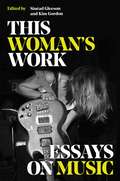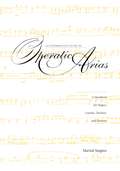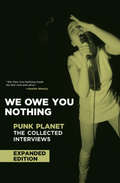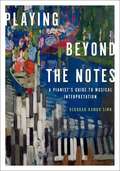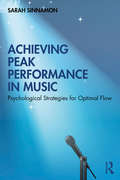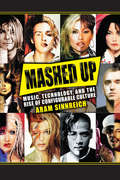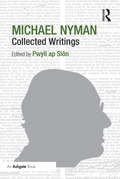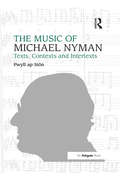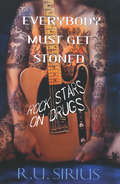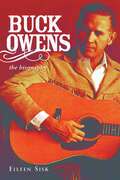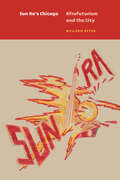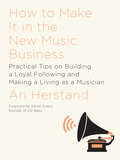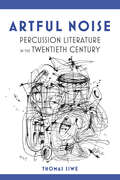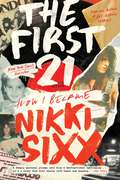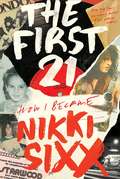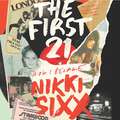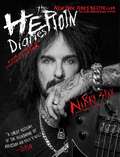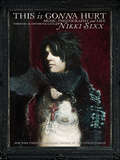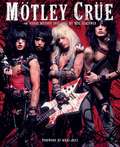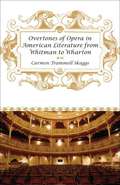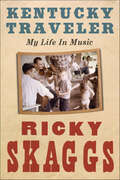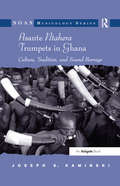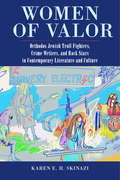- Table View
- List View
This Woman's Work: Essays on Music
by Sinéad Gleeson and Kim GordonEdited by iconic musician Kim Gordon and esteemed writer Sinéad Gleeson, this powerful collection of award-winning female creators shares their writing about the female artists that matter most to them. This book is for and about the women who kicked in doors, as pioneers of their craft or making politics central to their sound: those who offer a new way of thinking about the vast spectrum of women in music.This Woman&’s Work: Essays on Music is edited by iconic musician Kim Gordon and esteemed writer Sinéad Gleeson and features an array of talented contributors, including: Anne Enright, Fatima Bhutto, Jenn Pelly, Rachel Kushner, Juliana Huxtable, Leslie Jamison, Liz Pelly, Maggie Nelson, Margo Jefferson, Megan Jasper, Ottessa Moshfegh, Simone White, Yiyun Li, and Zakia Sewell.In this radical departure from the historic narrative of music and music writing being written by men, for men, This Woman&’s Work challenges the male dominance and sexism that have been hard-coded in the canons of music, literature, and film and has forced women to fight pigeon-holing or being side-lined by carving out their own space. Women have to speak up, to shout louder to tell their story—like the auteurs and ground-breakers featured in this collection, including: Anne Enright on Laurie Anderson; Megan Jasper on her ground-breaking work with Sub Pop; Margo Jefferson on Bud Powell and Ella Fitzgerald; and Fatima Bhutto on music and dictatorship.This Woman&’s Work also features writing on the experimentalists, women who blended music and activism, the genre-breakers, the vocal auteurs; stories of lost homelands and friends; of propaganda and dictatorships, the women of folk and country, the racialized tropes of jazz, the music of Trap and Carriacou; of mixtapes and violin lessons.
An Interpretive Guide to Operatic Arias: A Handbook for Singers, Coaches, Teachers, and Students
by Martial SingherA premier singer and master teacher here tells other singers how to get the most from 151 famous arias selected for their popularity or their greatness from 66 operas, ranging in time and style from Christopher Gluck to Carlisle Floyd, from Mozart to Menotti. “The most memorable thrills in an opera singer's life,” according to the author's Introduction, “may easily derive from the great arias in his or her repertoire.”This book continues the work Martial Singher has done, in performances, in concerts, and in master classes and lessons, by drawing attention “not only to precise features of text, notes, and markings but also to psychological motivations and emotional impulses, to laughter and tears, to technical skills, to strokes of genius, and even here and there to variations from the original works that have proved to be fortunate.”For each aria, the author gives the dramatic and musical context, advice about interpretation, and the lyric—with the original language (if it is not English) and an idiomatic American English translation, in parallel columns. The major operatic traditions—French, German, Italian, Russian, and American—are represented, as are the major voice types—soprano, mezzo-soprano, tenor, baritone, bass-baritone, and bass.The dramatic context is not a mere summary of the plot but is a penetrating and often witty personality sketch of an operatic character in the midst of a situation. The musical context is presented with the dramatic situation in a cleverly integrated way. Suggestions about interpretation, often illustrated with musical notation and phonetic symbols, are interspersed among the author's explication of the music and the action. An overview of Martial Singher’s approach—based on fifty years of experience on stage in a hundred roles and in class at four leading conservatories—is presented in his Introduction. As the reader approaches each opera discussed in this book, he or she experiences the feeling of participation in a rehearsal on stage under an urbane though demanding coach and director.The Interpretive Guide will be of value to professional singers as a source of reference or renewed inspiration and a memory refresher, to coaches for checking and broadening personal impressions, to young singers and students for learning, to teachers who have enjoyed less than a half century of experience, and to opera broadcast listeners and telecast viewers who want to understand what goes into the sounds and sights that delight them.
An Interpretive Guide to Operatic Arias: A Handbook for Singers, Coaches, Teachers, and Students
by Martial SingherA premier singer and master teacher here tells other singers how to get the most from 151 famous arias selected for their popularity or their greatness from 66 operas, ranging in time and style from Christopher Gluck to Carlisle Floyd, from Mozart to Menotti. “The most memorable thrills in an opera singer's life,” according to the author's Introduction, “may easily derive from the great arias in his or her repertoire.”This book continues the work Martial Singher has done, in performances, in concerts, and in master classes and lessons, by drawing attention “not only to precise features of text, notes, and markings but also to psychological motivations and emotional impulses, to laughter and tears, to technical skills, to strokes of genius, and even here and there to variations from the original works that have proved to be fortunate.”For each aria, the author gives the dramatic and musical context, advice about interpretation, and the lyric—with the original language (if it is not English) and an idiomatic American English translation, in parallel columns. The major operatic traditions—French, German, Italian, Russian, and American—are represented, as are the major voice types—soprano, mezzo-soprano, tenor, baritone, bass-baritone, and bass.The dramatic context is not a mere summary of the plot but is a penetrating and often witty personality sketch of an operatic character in the midst of a situation. The musical context is presented with the dramatic situation in a cleverly integrated way. Suggestions about interpretation, often illustrated with musical notation and phonetic symbols, are interspersed among the author's explication of the music and the action. An overview of Martial Singher’s approach—based on fifty years of experience on stage in a hundred roles and in class at four leading conservatories—is presented in his Introduction. As the reader approaches each opera discussed in this book, he or she experiences the feeling of participation in a rehearsal on stage under an urbane though demanding coach and director.The Interpretive Guide will be of value to professional singers as a source of reference or renewed inspiration and a memory refresher, to coaches for checking and broadening personal impressions, to young singers and students for learning, to teachers who have enjoyed less than a half century of experience, and to opera broadcast listeners and telecast viewers who want to understand what goes into the sounds and sights that delight them.
We Owe You Nothing: Expanded Edition (Punk Planet Bks.)
by Daniel SinkerUpdated with six more interviews and a new introduction, the expanded edition of We Owe You Nothing brings the definitive book of conversations with the underground's greatest minds up to 2007. New interviews include talks with bands like The Gossip and Maritime, a conversation with punk legend Bob Mould, and more . . . in addition to the classic interviews from the original 2001 edition: Ian MacKaye, Jello Biafra, Thurston Moore, Noam Chomsky, Kathleen Hanna, Black Flag, Sleater-Kinney, Steve Albini, Frank Kozik, Art Chantry, and others. Daniel Sinker has been the editor and publisher of Punk Planet magazine for twelve years.
Playing Beyond The Notes: A Pianist's Guide to Musical Interpretation
by Deborah Rambo SinnThis book demystifies the complex topic of musical interpretation by boiling it down to basic principles in an accessible writing style. The book targets pianists, piano teachers, and piano pedagogy students and incorporates over 200 musical examples from the intermediate and advanced piano repertoire.
Achieving Peak Performance in Music: Psychological Strategies for Optimal Flow
by Sarah SinnamonAchieving Peak Performance in Music: Psychological Strategies for Optimal Flow is a unique and comprehensive exploration of flow in music performance. It describes the optimal performance experiences of great musicians and outlines ten psychological steps that can be implemented to facilitate and enhance optimal experience. Achieving Peak Performance in Music reveals strategies used by experts to prepare themselves emotionally, cognitively, and physically for performance. Combining this information with research carried out amongst professional performers and knowledge gained from decades of study and research by psychologists on how to achieve a positive experience, the book guides readers on a pathway towards optimal performance. Using everyday language, it presents invaluable practical guidance and a toolbox of strategies to help with all aspects of performance, including memorisation, visualisation, focus, performance anxiety, thought management, motivation, and pre-performance routines. Based on psychological research, the book shares practical knowledge invaluable to music students, parents, and amateur and professional musicians. The strategies on performance provided are applicable to every type of performance, from a student exam to a gig or a concert, making Achieving Peak Performance in Music a significant resource for anyone looking to achieve peak performance.
Mashed Up: Music, Technology, and the Rise of Configurable Culture
by Aram SinnreichFrom ancient times to the present day, writers and thinkers have remarked on the unique power of music to evoke emotions, signal identity, and bond or divide entire societies, all without the benefit of literal representation. Even if we can't say precisely what our favorite melody means, we know very well what kind of effect it has on us, and on our friends and neighbors. According to Aram Sinnreich, this power helps to explain why music has so often been regulated in societies around the globe and throughout history. Institutional authorities ranging from dynastic China's "Office to Harmonize Sounds" to today's copyright collecting societies like BMI and ASCAP leverage the rule of law and the power of the market to make sure that some musical forms and practices are allowed and others are prohibited. Yet, despite the efforts of these powerful regulators, musical cultures consistently devise new and innovative ways to work around institutional regulations. These workarounds often generate new styles and traditions in turn, with effects far beyond the cultural sphere. Mashed Up chronicles the rise of "configurability," an emerging musical and cultural moment rooted in today's global, networked communications infrastructure. Based on interviews with dozens of prominent DJs, attorneys, and music industry executives, the book argues that today's battles over sampling, file sharing, and the marketability of new styles such as "mash-ups" and "techno" presage social change on a far broader scale. Specifically, the book suggests the emergence of a new ethic of configurable collectivism; an economic reunion of labor; a renegotiation of the line between public and private; a shift from linear to recursive logic; and a new "DJ consciousness," in which the margins are becoming the new mainstream. Whether these changes are sudden or gradual, violent or peaceful, will depend on whether we heed the lessons of configurability, or continue to police and punish the growing ranks of the mashed up.
Michael Nyman: Collected Writings
by Pwyll ap SiônFor over three decades Michael Nyman's music has succeeded in reaching beyond the small community of contemporary music aficionados to a much wider range of listeners. An important element in unlocking the key to Nyman's success lies in his writings about music, which preoccupied him for over a decade from the late 1960s to the early 1980s. During this time Nyman produced over 100 articles, covering almost every conceivable musical style and genre - from the Early Music revival and the West's interest in 'world' music, or from John Cage and minimalism to rock and pop. Nyman initiated a number of landmark moments in the course of late twentieth-century music along the way: he was one of the first to critique the distinction between the European avant-garde and the American experimental movement; he was the first to coin the term 'minimalism' in relation to the music of (then largely unknown) Steve Reich and Terry Riley, and later Philip Glass; the first to seriously engage with the music of the English experimental tradition and the importance of Cornelius Cardew, and to identify the importance of Art Colleges in nurturing and developing a radical alternative to modernism; and one of the first writers to grasp the significance of post-minimalists such as Brian Eno and Harold Budd, and to realize how these elements could be brought together into a new aesthetic vision for his own creative endeavours, which was formulated during the late 1970s and early 80s. Much of what transformed and defined Nyman's musical character may be found within the pages of this volume of his writings, comprehensively edited and annotated for the first time, and including previously unpublished material from Nyman's second interview with Steve Reich in 1976. There is also much here to engage the minds of those who are interested in pre-twentieth century music, from Early and Baroque music (Handel and Purcell in particular) to innovative features in Haydn, spatial elements in Berlioz, or Bruckner and Mahler's symphonic works.
The Music of Michael Nyman: Texts, Contexts and Intertexts
by Pwyll ap SiônNyman's rise to international prominence during the last three decades has made him one of the world's most successful living composers. His music has nevertheless been criticized for its parasitic borrowing of other composers' ideas and for its relentless self-borrowing. In this first book-length study in English, Pwyll ap Si laces Nyman's writings within the general context of Anglo-American experimentalism, minimalism and post-minimalism, and provides a series of useful contexts from which controversial aspects of Nyman's musical language can be more clearly understood and appreciated. Drawing upon terms informed by intertextual theory in general, appropriation and borrowing are first introduced within the context of twentieth-century art music and theory. Intertextual concepts are explained and their terms defined before Nyman's musical language is considered in relation to a series of intertextual classifications and types. These types then form the basis of a more in-depth study of his works during the second half of the book, ranging from opera and chamber music to film. Rather than restricting style and technique, Nyman's intertextual approach, on the contrary, is shown to provide his music with an almost infinite amount of variety, flexibility and diversity, and this has been used to illustrate a wide range of technical, aesthetic and expressive forms. He composes with his ear towards the past as if it were a rich quarry to mine, working like a musical archaeologist, uncovering artefacts and chiselling fresh and vibrant sonic edifices out of them.
Everybody Must Get Stoned: Rock Stars On Drugs
by R. U. SiriusKeith's on guitar, Charlie's on drums, and Ronnie's on rhythm. But who's on drugs? Everybody.Welcome to the red-eyed world of rock and roll, where every riff comes with a spliff--a coked-up compendium of your favorite musicians and their favorite drugs. Loaded with sordid tales of debauchery, lists, and bleary-eyed photos, there's more stuff in here than in one of Snoop Dogg's favorite brownies, including: * The Top Ten Albums to Tweak to * The Top Ten Rock Star Drug Quotes * The Top Ten Drug Busts in Rock * Extreme acid casualties * Outrageous drug stories of rock legends * The secret history of Dylan and drugs * Henry Rollins and Frank Zappa: How to act like you're on drugs without actually doing any * And the answer to the ever popular rock and roll drug question, "Who gave the Beatles their first hits of acid?" (Their dentist!)So put on your favorite CD, don't try the green acid, and enjoy! Note: Pages are not suitable for rolling papers. R. U. Sirius (aka Ken Goffman) is the co-editor of 10 Zen Monkeys and the host of two weekly podcasts, "The R.U. Sirius Show" and "Neo-Files with R. U. Sirius." He has worked as a columnist for ArtForum International and The San Francisco Examiner. He has written for Time, Esquire, Wired, and Boing Boing. He is the author of CounterCulture Through the Ages: From Abraham to Acid House, How to Mutate and Take Over the World, and The CyberPunk Handbook, and co-author of Design for Dying with Timothy Leary. He lives in Mill Valley, California.
Buck Owens: The Biography
by Eileen SiskRetracing the life of Buck Owens--from his poverty-stricken youth as the son of a sharecropper to one of the nation's best-loved and wealthiest entertainers--this biography pays tribute to the man and his music by revealing his genius, his warmth, his humor, his vulnerabilities, and his flaws. It is based on personal sources, including original and latter-day Buckaroos, the cohost and the producer of Hee Haw, the former president of Capitol Nashville, and numerous country singers, relatives, ex-wives, ex-lovers, and ex-employees. The result is a 360-degree profile of a shrewd businessman--the polar opposite of the aw-shucks image he cultivated on Hee Haw. Owens was the top-selling country act of the 1960s--with 21 number-one hits and 35 consecutive top-10 hits from 1962 to 1972, a total surpassed only by the Beatles. One of his major contributions to this era was his invention of the Bakersfield sound, mixing electric guitars with a rock 'n' roll beat, which became popular with country and rock fans alike. This biography details the rift Buck had with the Nashville establishment, his reasons for never becoming a member of the Grand Ole Opry, the number of times Buck married, the truth about Buck posing in the nude for Playgirl, and his strained but professional relationship with Hee Haw cohost Roy Clark.
Sun Ra's Chicago: Afrofuturism and the City (Historical Studies of Urban America)
by William SitesSun Ra (1914–93) was one of the most wildly prolific and unfailingly eccentric figures in the history of music. Renowned for extravagant performances in which his Arkestra appeared in neo-Egyptian garb, the keyboardist and bandleader also espoused an interstellar cosmology that claimed the planet Saturn as his true home. In Sun Ra’s Chicago, William Sites brings this visionary musician back to earth—specifically to the city’s South Side, where from 1946 to 1961 he lived and relaunched his career. The postwar South Side was a hotbed of unorthodox religious and cultural activism: Afrocentric philosophies flourished, storefront prophets sold “dream-book bibles,” and Elijah Muhammad was building the Nation of Islam. It was also an unruly musical crossroads where the man then known as Sonny Blount drew from an array of intellectual and musical sources—from radical nationalism, revisionist Christianity, and science fiction to jazz, blues, Latin dance music, and pop exotica—to construct a philosophy and performance style that imagined a new identity and future for African Americans. Sun Ra’s Chicago shows that late twentieth-century Afrofuturism emerged from a deep, utopian engagement with the city—and that by excavating the postwar black experience of Sun Ra’s South Side milieu, we can come to see the possibilities of urban life in new ways.
Liszt
by Sacheverell SitwellBiography of the famous composer, a man of extraordinary magnetism and a pianist of unsurpassed virtuosity. Bibliography and a catalog of Liszt's works included.
How To Make It in the New Music Business: Practical Tips On Building A Loyal Following And Making A Living As A Musician
by Derek Sivers Ari Herstand"Ari is at the front of the front. He gets it. I've read a hundred how-to-make-it-in-the-music-biz books, and this one is today's definitive, comprehensive manual." —Jack Conte, 150+ million YouTube views, Pomplamoose, CEO of Patreon Forget everything you think you know about the odds of “making it” in the music industry. Today, odds mean nothing and success is not about lucky breaks. It’s about conquering social media, mastering the art of merchandising and simply working harder and being smarter than everyone else. We are living in the midst of an industry renaissance, one that has left the record companies desperately struggling to maintain their prominence, as a subculture of dedicated, DIY (do-it-yourself) musicians have taken over. These days talent is a given and success has to be earned. In 2008, Ari Herstand boldly turned in his green Starbucks apron to his manager, determined to make a living off his craft as a singer/songwriter. Almost a decade later, he has become a founding member of the new DIY movement and a self-sustaining musician, all without the help of a major label. Now, drawing from years of experience, Herstand has written the definitive guide for other like-minded artists, the ones who want to forge their own path and not follow the traditional markers of success, like record sales, hits on the radio or the amount of your label advance. Incredibly comprehensive and brutally honest throughout, How to Make It in the New Music Business covers every facet of the "new" business, including how to: Build a grass-roots fan base—and understand the modern fan Book a profitable tour, and tips for playing live, such as opening vs. headlining etiquette, and putting on a memorable show Become popular on YouTube, Spotify and SoundCloud Get songs placed in film and television Earn royalties you didn’t know existed and reach your crowdfunding goals Musicians will not only be introduced to all the tools available today but will be shown how to effectively leverage them to actually make money. More important, they will develop the mindset to be aware of new advancements both online and in the real world and always stay in tune with a constantly evolving landscape. There has never been a better time to be an independent musician. Today, fans can communicate with their idols by simply picking up their phones, artists are able to produce studio-worthy content from their basement and albums are funded not by "record men" but by generous, engaged supporters. As result, How to Make It in the New Music Business is a must-have guide for anyone hoping to navigate the increasingly complex yet advantageous landscape that is the modern music industry.
Artful Noise: Percussion Literature in the Twentieth Century (Music in American Life #502)
by Thomas SiweTwentieth-century composers created thousands of original works for solo percussion and percussion ensemble. Concise and ideal for the classroom, Artful Noise offers an essential and much-needed survey of this unique literature. Percussionist Thomas Siwe organizes and analyzes the groundbreaking musical literature that arose during the twentieth century. Focusing on innovations in style and the evolution of the percussion ensemble, Siwe offers a historical overview that connects the music to scoring techniques, new instrumentation and evolving technologies as well as world events. Discussions of representative pieces by seminal composers examines the resources a work requires, its construction, and how it relates to other styles that developed during the same period. In addition, Siwe details the form and purpose of many of the compositions while providing background information on noteworthy artists. Each chapter is supported with musical examples and concludes with a short list of related works specifically designed to steer musicians and instructors alike toward profitable explorations of composers, styles, and eras.
The First 21: How I Became Nikki Sixx
by Nikki SixxRock-and-roll icon and three-time bestselling author Nikki Sixx tells his origin story: how Frank Feranna became Nikki Sixx, chronicling his fascinating journey from irrepressible Idaho farmboy to the man who formed the revolutionary rock group Mötley Crüe. <P><P> Nikki Sixx is one of the most respected, recognizable, and entrepreneurial icons in the music industry. As the founder of Mötley Crüe, who is now in his twenty-first year of sobriety, Sixx is incredibly passionate about his craft and wonderfully open about his life in rock and roll, and as a person of the world. Born Franklin Carlton Feranna on December 11, 1958, young Frankie was abandoned by his father and partly raised by his mother, a woman who was ahead of her time but deeply troubled. Frankie ended up living with his grandparents, bouncing from farm to farm and state to state. He was an all-American kid—hunting, fishing, chasing girls, and playing football—but underneath it all, there was a burning desire for more, and that more was music. He eventually took a Greyhound bound for Hollywood. <P><P> In Los Angeles, Frank lived with his aunt and his uncle—the president of Capitol Records—for a short time. But there was no easy path to the top. He was soon on his own. There were dead-end jobs: dipping circuit boards, clerking at liquor and record stores, selling used light bulbs, and hustling to survive. But at night, Frank honed his craft, joining Sister, a band formed by fellow hard-rock veteran Blackie Lawless, and formed a group of his own: London, the precursor of Mötley Crüe. <P><P> Turning down an offer to join Randy Rhoads’s band, Frank changed his name to Nikki London, Nikki Nine, and, finally, Nikki Sixx. Like Huck Finn with a stolen guitar, he had a vision: a group that combined punk, glam, and hard rock into the biggest, most theatrical and irresistible package the world had ever seen. With hard work, passion, and some luck, the vision manifested in reality—and this is a profound true story finding identity, of how Frank Feranna became Nikki Sixx. It's also a road map to the ways you can overcome anything, and achieve all of your goals, if only you put your mind to it. <P><P><b>A New York Times Best Seller</b>
The First 21: The New York Times Bestseller
by Nikki SixxNikki Sixx is one of the most respected, recognizable, and entrepreneurial icons in the music industry. As the founder of Mötley Crüe who is now in his twenty-first year of sobriety, Sixx is incredibly passionate about his craft and wonderfully open about his life in rock and roll, and as a person of the world.Born Franklin Carlton Feranna on December 11, 1958, young Frankie was abandoned by his father and partly raised by his mother, a woman who was ahead of her time in some ways and deeply troubled in others. Frankie ended up living with his grandparents, bouncing from farm to farm and state to state. He was an all-American kid-hunting, fishing, chasing girls, and playing football-but underneath it all, there was a burning desire for more, and that more was music. He eventually took a Greyhound bound for Hollywood.In Los Angeles, Frank lived with his aunt and his uncle-the president of Capitol Records. But there was no short path to the top. He was soon on his own. There were dead-end jobs: dipping circuit boards, clerking at liquor and record stores, selling used light bulbs, and hustling to survive. But at night, Frank honed his craft, joining Sister, a band formed by fellow hard-rock veteran Blackie Lawless, and formed a group of his own: London, the precursor of Mötley Crüe. Turning down an offer to join Randy Rhoads' band, Frank changed his name to Nikki London, Nikki Nine, and, finally, Nikki Sixx. Like Huck Finn with a stolen guitar, he had a vision: a group that combined punk, glam, and hard rock into the biggest, most theatrical and irresistible package the world had ever seen. With hard work, passion, and some luck, the vision manifested in reality - and this is a profound true story finding identity, of how Frank Feranna became Nikki Sixx. And it's a road map to the ways you can overcome anything, and achieve all of your goals, if only you put your mind to it.
The First 21: The New York Times Bestseller
by Nikki SixxThe New York Times bestsellerNikki Sixx is one of the most respected, recognizable, and entrepreneurial icons in the music industry. As the founder of Mötley Crüe who is now in his twenty-first year of sobriety, Sixx is incredibly passionate about his craft and wonderfully open about his life in rock and roll, and as a person of the world.Born Franklin Carlton Feranna on December 11, 1958, young Frankie was abandoned by his father and partly raised by his mother, a woman who was ahead of her time in some ways and deeply troubled in others. Frankie ended up living with his grandparents, bouncing from farm to farm and state to state. He was an all-American kid-hunting, fishing, chasing girls, and playing football-but underneath it all, there was a burning desire for more, and that more was music. He eventually took a Greyhound bound for Hollywood.In Los Angeles, Frank lived with his aunt and his uncle-the president of Capitol Records. But there was no short path to the top. He was soon on his own. There were dead-end jobs: dipping circuit boards, clerking at liquor and record stores, selling used light bulbs, and hustling to survive. But at night, Frank honed his craft, joining Sister, a band formed by fellow hard-rock veteran Blackie Lawless, and formed a group of his own: London, the precursor of Mötley Crüe. Turning down an offer to join Randy Rhoads' band, Frank changed his name to Nikki London, Nikki Nine, and, finally, Nikki Sixx. Like Huck Finn with a stolen guitar, he had a vision: a group that combined punk, glam, and hard rock into the biggest, most theatrical and irresistible package the world had ever seen. With hard work, passion, and some luck, the vision manifested in reality - and this is a profound true story finding identity, of how Frank Feranna became Nikki Sixx. And it's a road map to the ways you can overcome anything, and achieve all of your goals, if only you put your mind to it.
The Heroin Diaries: A Year in the Life of a Shattered Rock Star
by Nikki SixxIn one of the most unique memoirs of addiction ever published, MÖtley CrÜe's Nikki Sixx shares mesmerizing diary entries from the year he spiraled out of control in a haze of heroin and cocaine, presented alongside riveting commentary from people who were there at the time, and from Nikki himself. When MÖtley CrÜe was at the height of its fame, there wasn't any drug Nikki Sixx wouldn't do. He spent days -- sometimes alone, sometimes with other addicts, friends, and lovers -- in a coke and heroin-fueled daze. The highs were high, and Nikki's journal entries reveal some euphoria and joy. But the lows were lower, often ending with Nikki in his closet, surrounded by drug paraphernalia and wrapped in paranoid delusions. Here, Nikki shares those diary entries -- some poetic, some scatterbrained, some bizarre -- and reflects on that time. Joining him are Tommy Lee, Vince Neil, Mick Mars, Slash, Rick Nielsen, Bob Rock, and a host of ex-managers, ex-lovers, and more. Brutally honest, utterly riveting, and shockingly moving, The Heroin Diaries follows Nikki during the year he plunged to rock bottom -- and his courageous decision to pick himself up and start living again.
This Is Gonna Hurt: Music, Photography and Life Through the Distorted Lens of Nikki Sixx
by Nikki SixxThis Is Gonna Hurt is music, photography, and life through the distorted lens of Nikki Sixx, bassist for heavy metal rock band Mötley Crüe’s and the New York Times bestselling author of The Heroin Diaries. A combination of powerful prose and dramatic photographs, This Is Gonna Hurt is an arresting, deeply personal look through the eyes of a real rock star at a stark, post-addiction world.This Is Gonna Hurt chronicles Sixx's experiences—from his early years filled with toxic waste, to his success with Motley Crue, to his near death from an OD and his eventual rebirth through music, photography, and love. Love story, social commentary, family memoir, This Is Gonna Hurt offers the compelling insights of an artist and a man struggling to survive, connect, and find a happy ending—a search that fuels Sixx's being.
Motley Crue
by Nikki Sixx Neil ZlozowerMötley Crüe's gleeful glam debauchery and unstoppable anthems have made them metal gods, selling over 72 million album copies worldwide and landing their band biography The Dirt on bestseller lists around the country. Mötley Crüe is--amazingly--the first photographic history of the band. Legendary rock photographer Neil Zlozower's images capture the band's rise from their breakthrough album Shout at the Devil through rock 'n' roll excesses to follow with the unprecedented all-access candor of a friend to the band. In hundreds of photographs and stories from the band and those close to them, Mötley Crüe reveals them onstage, backstage, on tour, hanging out, and in studio--a must-have album of photos and testimony on one of the most powerful and controversial bands in rock history.
Overtones of Opera in American Literature from Whitman to Wharton
by Carmen Trammell SkaggsIn this captivating work, Carmen Trammell Skaggs examines the discourse of opera -- both the art form and the social institution -- in nineteenth- and early twentieth-century American literature. Through the lens of opera, she maintains, major American writers -- including Walt Whitman, Edgar Allan Poe, Louisa May Alcott, Kate Chopin, Willa Cather, Henry James, and Edith Wharton -- captured the transformations of a rapidly changing American literary landscape. Although they turned to opera for different reasons, they all saw a twofold function in the art form: a means of expressing a private aesthetic experience and a space in which to perform highly ritualized social functions.Skaggs opens with an exploration of Whitman, who believed that the opera singer infuses ordinary speech with an element of the divine. Through his poetry, he sought to transform these sacred intonations into vehicles of an artistic transcendence that could be experienced by his audience. Skaggs then turns to Poe and Alcott, who frequently imitated the excesses of opera in their fiction, flamboyantly enjoying the element of the absurd. Using opera as a setting in their work allowed them to explore the fallibility of human sensibility, especially our susceptibility to deception.Chopin and Cather, Skaggs shows, empowered their heroines with a voice, a medium for artistic transcendence, but they were also influenced by the growing popularity of Wagnerian opera -- and of the idea that only through a sublimation of life can transfiguration of the soul occur. The true artist, they believed, inevitably lived a solitary life, sacrificing all for art. In the diva, for instance, Cather saw the ideal embodiment of the female artist. On the other hand, James and Wharton, Skaggs explains, recognized the opera box as the ideal setting for social considerations of class, codes, and customs in many of their stories and novels. Past literary critics have employed musical terminology to evoke what opera historian Herbert Lindenberger describes as a "nonverbal dimension beyond what we ordinarily take to be the realm of literature," but many of these same scholars warily embraced an operatic approach. After all, the "operatic" often suggests artificiality and extravagance -- qualities usually seen as negative in writing. Despite the undisputed canonical status of many of the works Skaggs explores, at least a few of them might also be described in similarly operatic (and disparaging) terms. The critical discourse of opera, however, offers an ideal vehicle for opening these texts in a new way.Unveiling a heretofore seldom-noticed connection between the rise of opera in America and the flowering of American literature, Skaggs's noteworthy study will inform and enlighten literary scholars, musicologists, and lovers of both opera and literature.
Kentucky Traveler: My Life in Music
by Ricky SkaggsIn Kentucky Traveler, Ricky Skaggs, the music legend who revived modern bluegrass music, gives a warm, honest, one-of-a-kind memoir of forty years in music—along with the Ten Commandments of Bluegrass, as handed down by Ricky’s mentor Bill Monroe; the Essential Guide to Bedrock Country Songs, a lovingly compiled walk through the songs that have moved Skaggs the most throughout his life; Songs the Lord Taught Us, a primer on Skaggs’s most essential gospel songs; and a bevy of personal snapshots of his musical heroes.For readers of Johnny Cash’s autobiography, lovers of O Brother Where Art Thou, and fans of country music and bluegrass, Kentucky Traveler is a priceless look at America’s most cherished and vibrant musical tradition through the eyes of someone who has lived it.
Asante Ntahera Trumpets in Ghana: Culture, Tradition, and Sound Barrage (SOAS Studies in Music)
by Joseph S.KaminskiBased on the author's fieldwork in Ghana with the Asante and Denkyira ntahera trumpeters, this book draws on interviews, field recordings, oral traditions, written accounts, archaeological evidence, transcriptions and linguistic analyses to situate the Asante trumpet tradition in historical culture. There are seven ivory trumpet ensembles in residence at the Asante Manhyia Palace in Kumase, and ivory trumpets are blown at every Akan court. The Asante trumpets, which are made from elephant tusks, are symbols of Asante strength and have an important role in Asante cosmology. Surrogate speech is performed via lipped tones through a tusk in praise of the Asante royal ancestors and the living Asante king. This book contains transcriptions and analyses of surrogate speech texts and their accompanying ensemble songs. When several ensembles play simultaneously as a representation of power, they make staggered entrances, beginning separate songs in order. This results in a simultaneous performance of separate songs. This phenomenon, which Kaminski has termed 'sound-barrage', is an ancient aesthetic, and is performed to protect the kingdom and the ancestors. It is both spiritual and acoustical. This 'sound barrage' is believed to act in the metaphysical world, dispelling evil spirits from court rituals, ancestor venerations, and funerals, for there is a spirit in the sound.
Women of Valor: Orthodox Jewish Troll Fighters, Crime Writers, and Rock Stars in Contemporary Literature and Culture
by Karen E. SkinaziMedia portrayals of Orthodox Jewish women frequently depict powerless, silent individuals who are at best naive to live an Orthodox lifestyle, and who are at worst, coerced into it. Karen E. H. Skinazi delves beyond this stereotype in Women of Valor to identify a powerful tradition of feminist literary portrayals of Orthodox women, often created by Orthodox women themselves. She examines Orthodox women as they appear in memoirs, comics, novels, and movies, and speaks with the authors, filmmakers, and musicians who create these representations. Throughout the work, Skinazi threads lines from the poem “Eshes Chayil,” the Biblical description of an Orthodox “Woman of Valor.” This proverb unites Orthodoxy and feminism in a complex relationship, where Orthodox women continuously question, challenge, and negotiate Orthodox and feminist values. Ultimately, these women create paths that unite their work, passions, and families under the framework of an “Eshes Chayil,” a woman who situates religious conviction within her own power.
